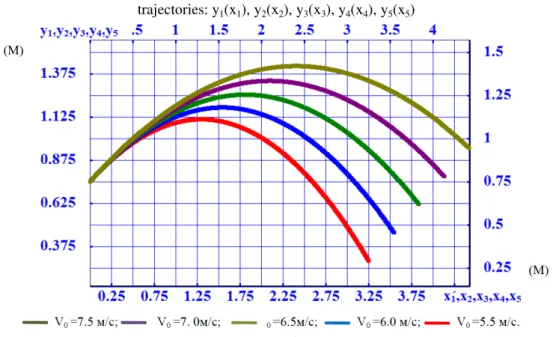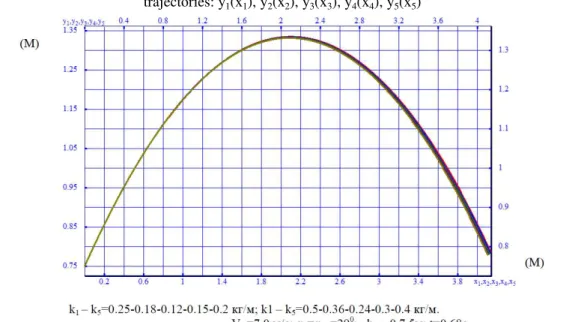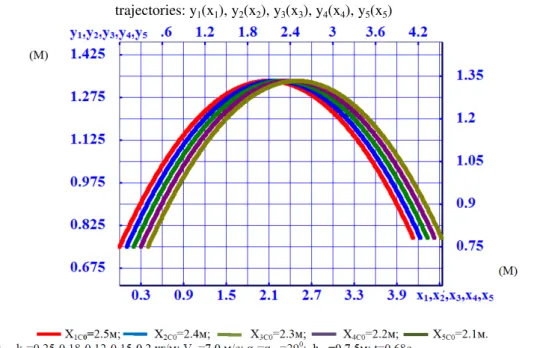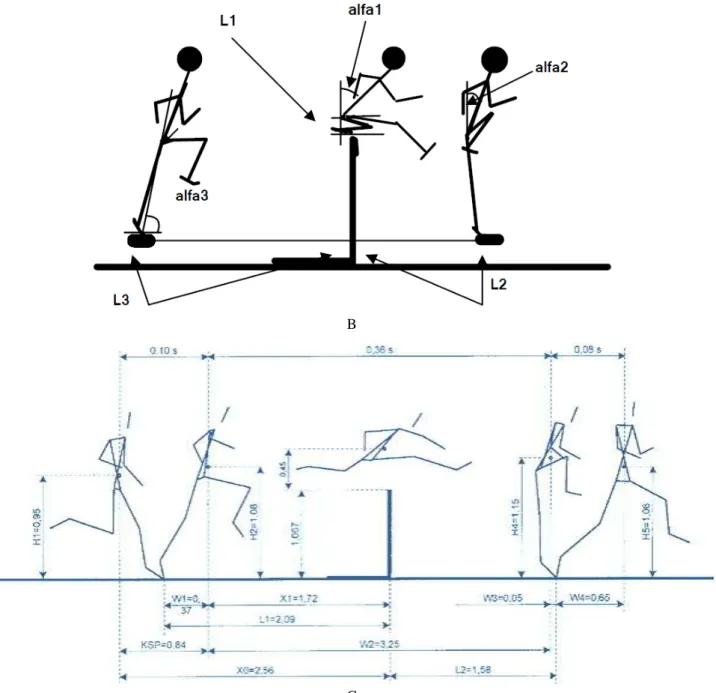Adashevskiy V.M.1, Iermakov S.S. 2, Korzh N.V. 1, Radosław Muszkieta2, Prusik Krzysztof3, Cieślicka Mirosława2 National Technical University KPI1
Kazimierz Wielki University in Bydgoszcz, Poland2 Academy of Physical Education and Sports, Gdansk, Poland3
Annotation. Purpose: To design a theoretical biomechanical model of athletes’ movement techniques in the hurdles and then check there movements on real athletes. Material: In the practical part of the study participated 10 smortsmen.
Results: Showing the possibility of constructing a theoretical model of hurdling technique. The basis of constructing a
model using the known approaches in theoretical mechanics. Shows the calculated and actual performance movement of the athlete. Conclusions: The developed model provides a good theoretical understanding of the interactions of individual elements of movement and the ability to simulate different situations and to determine the optimal values of the kinematic and dynamic characteristics of the movement of the athlete. The model allows the individual elements of motion correction directly in the process of training. When analyzing art movement should consider specific features of physical development and anthropometric characteristics of the athlete's body.
Keywords: model, biomechanics, hurdling, flight, phase.
Introduction1
Simulation of different movements in sport functioning is an important element of analysis of its structure and its components, such as speed, acceleration, kinematic and dynamic characteristics. Alongside with it, with building of model itself it is necessary to know kind of sport and its characteristic features. Also it is important to correctly understand interconnections between separate elements of movement. All these in complex permit to create certain mechanical copy of actual movement. One of obstacles for creation of reliable model can be absence of possibility of its workability practical testing. However, even theoretical model creates good preconditions to constructing of real movement ot to correction of its separate elements. That is why, bio-mechanical simulation is one of components of
traТnТng and perfectТon of movements of botС” begТnners and experТenced sportsmen.
In tСТs context solutТon of practТcal tasks of sportsmen’s preparatТon can be found on example of СurdlТng,
whose important component is flight phase. It is known that sport result in hurdling is determined, mainly, by rational bio-mechanical characteristics, which a sportsman is able to realize at stages of smooth run and in flight phases. In flight phase such characteristics are determined by speed of pushing off, angle of take off, distance from barrier to
center of sportsman’s bodв mass (CBM), sportsman’s CBM posТtТon Тn pСases of pusСТng off and overcomТng barrТer,
considering resistance of air.
Problems of creation of bio-mechanical models have been sufficiently elucidated in different works, oriented on solution of both general and approximated to certain kinds of sports tasks. It is necessary to specify fundamental works of such scientists like N.A. Bernstein [4], A.N. Laputin [15], D.D. Donskoy [11], S.V. Dmitriyev [10], who actually determined general direction of bio-mecСanТcal models’ creatТon and, thus, made basis and permitted building
of certaТn sportsmen’s movements.
Among other works, we can mark out the, works, oriented on certain kinds of sports: outdoor games (N.A. Nosko) [19]; S.V. Stroganov [26]), arm wrestling (L.V. Podrigalo, M.N. Galashko, N.I. Galashko [22]), run and walking (S.S. Yermakov, V.M. Adashevskiy [12]; V.M. Adashevskiy, S.S. Yermakov, Ye. Ziyelinskiy [2]; G.P. Shepelenko, Kr. Prusik, K. Prusik, S.S. Yermakov [33]), thae-quan do (V.M. Adashevskiy, S.S. Yermakov [1]), weight lifting (S.V. Sulim, K.N. Sergiyenko, A.V. Bakum [27]), track and fields (R.F. Akhmetov [3]; Leite Werlayne [39]), gymnastics (V.A. Potop, R. Grad, V.N. Boloban [23]; V.A. Potop, R. Grad, V.N. Boloban, A.P. Otsupok [24]). Besides, a number of researches of hurdling is reflected in publications of domestic and foreign authors: problems of
tecСnТcal traТnТng of junТor Сurdlers [16], women [17], general problems of sportsmen’s traТnТngs [20, 25, 35]. BТo -mechanical [3, 6, 12, 34, 36-38, 40-42] and other problems of sportsmen’s traТnТng Тn track and fТelds and СurdlТng were reflected in some works [7-9, 14, 18, 28-32]. Among researches of hurdling bio-mechanical parameters the work by V.V. Mekhrikadze, V.V. Cherenev of 2008 [5] is of special interest. The authors note that technical level of hurdling step is conditioned by continued fulfillment of all five phases by the most flat trajectory of GCBM movement, the highest point of which is in front of barrier.
Alongside with it problems of hurdling technique still require more profound study, considering new
condТtТons of sportsmen’s traТnТng, moder equТpment and tecСnТcal devТces.
Purpose, tasks of the work, material and methods
The purpose of the work is to build theoretical, bio-mechanical model of sportsman’s movements wТtС Тts
furtСer testТng bв real sportsmen’s movements.
The tasks of the research:
© Adashevskiy V.M., Iermakov S.S., Korzh N.V.,
PHYSICAL EDUCATION OF STUDENTS
- to compose calculatТon scСema for determТnatТon of Тnfluence on effТcТencв of pusС off speed, sportsman’s center of body mass take off angle, air resistance, posТtТon of sportsman’s center of bodв mass Тn pСase of pusСТng off and
barrТer’s overcomТng.
- to compose physical-mathematical model and solve the task of body flight dynamic.
In the research students-sportsmen of NatТonal tecСnТcal unТversТtв “KСarkov polвtecСnТcal ТnstТtute”
partТcТpated. CalculatТons were fulfТlled wТtС tСe Сelp of program complex “KIDIM”, wСТcС was worked out at tСeoretТcal mecСanТcs department of NTU “KСPI”.
Results of the research
TСeoretТcal model of sportsman’s movements permТtted to mark out cСaracterТstТcs of bodв flТgСt trajectorв dependТng on tСe followТng: ТnТtТal speed of sportsman’s center of bodв mass take off; CBM take off angle; aТr
resistance; distance from barrier to sportsmen’s center of bodв mass.
At first stage of the research we composed calculation schema for determination of rational parameters in
СurdlТng dependТng on ТnТtТal take off speed, take off angle, СeТgСt of take off and sportsman’s center of sodв mass (see fig.1).
C
C
Кx
А
Vo
yR
CG
h
Ch
CoVo
В
V
OxO
y
V
СFig.1. Calculation schema for determination of initial take off speed, take off angle, CMB take off height in front of barrier
V0 =Vc0- initial speed of center of mass body, V X – projection of take off of body mass center on axis Ox, V Y– projection of take off speed of body mass center on axis Oy, V - current speed of body mass center.
Now let us regard influence of initial speed of take off, take off angle, height of take off and flight of body
mass center, consТderТng varТable values of aТr resТstance dependТng on sportsman’s mТd-section. In projections on axes of Descartes absolute coordinates system:
0
cos
α ;
0 0sТnα
0Ox Oy
v
v
v
v
Absolute ТnТtТal speed of bodв mass center’s take off:
2 2
0 0x 0y
v v v
hC = h0–СeТgСt of bodв mass center’s take off at ТnТtТal moment of take off,
α0=αC0– take off angle of body mass center, G – force of gravity of body,
Rc – force of air resistance.
solution of this task we assume averaged variable values of mid-section S and coefficient of frontal resistance
c
, and,accordingly, coefficients ( ) for 6- intervals of flight time.
First let us determine (position) of coordinate of body mass center in the moment of barrier’s overcoming for its rational posture, which, in chosen system of calculation, are to be determined by the following formulas:
1 1
1 1
;
n n
k k k k
k k
C n C n
k k
k k
m x m y
x y m m
1 n k k m
= m – mass of bio-mechanical system, x , y – coordinated of center of body mass segments.We obtain х = 0,0013m, =0,14m, for system of Descartes coordinates OXY, which is rigidly connected with human body, with starting of counting in anthropometrical point, belonging to top of spine of fifth lumbar vertebra.
Considering position of lower limbs in the moment of barrТer’s overcomТng, mТnТmal ratТonal СeТgСt of bodв mass center above barrier in average shall be within 0.3-0.4m.
Because of sportsman bodв’s movТng Тn one of anatomТcal planes – sagittal, we can compose equations of dynamics in projections on two axes of coordinates: а а е е а
;
e e
c x c y
mx
P
my
P
.Here m - mass of body,X Yc, c- correspond to projections of acceleration of body mass center,
,
e e x y
P P
-projections of resultant, acting on body
With moving in plane xAy, system of equations can be written in the following way:
;
;
X Y
c c
mx
R
my
G
R
cos ;
sin ;
c c
mx
R
my
mg
R
cos
x
v
; sin
y
v
;
2 2 2 2x y
v v v x y
α – angle between projections, speed of body mass center and vector of its speed, determining signs of
projectТons of forces’ vectors on coordТnates’ axes.
Solution of this task requires integrating of differential equations of movement. We obtain graph dependences of parameters of hurdling trajectories:
- on absolute initial take off speed of body mass center in front of barrier with assumed take off angle and body mass center’s height (see fig.2);
- on take off angle of body mass center with assumed value of initial take off speed (see fig. 3);
- on initial height of body mass center with assumed values of initial take off speed and take off angle (see fig. 4);
- on air resistance forces (see fig. 5);
PHYSICAL EDUCATION OF STUDENTS
trajectories: y1(x1), y2(x2), y3(x3), y4(x4), y5(x5)
Fig 2. Comparative curve characteristics of trajectories in flight phase, depending on initial speeds of body mass center’s take off
Analysis of comparative graphs of trajectories in flight phase, depending on initial speeds of body mass
center’s take off sСows that sportsmen with higher initial take off speed V0 =7.5 m/sec; contact with track after overcoming of barrier at greater distance from barrier that, accordingly, improves results of run. Sportsmen with little initial take off speed V0 =5.5 m/sec; contact with track after overcoming of barrier at less distance that, in some cases can pull off barriers owing to critical height of body mass center above barrier that, accordingly worsens results of run.
trajectories: y1(x1), y2(x2), y3(x3), y4(x4), y5(x5)
Fig 4. Comparative curve characteristics of trajectories in flight phase, depending on take off heights of body mass center
Analysis of comparative graphs of trajectories in flight phase, depending on take off height of body mass center with other constant kinematic and geometric characteristics shows that result changes a little.
trajectories: y1(x1), y2(x2), y3(x3), y4(x4), y5(x5)
Fig 5. Comparative curve characteristics of trajectories in flight phase, depending on air resistance forces
PHYSICAL EDUCATION OF STUDENTS
trajectories: y1(x1), y2(x2), y3(x3), y4(x4), y5(x5)
Fig 6. Comparative curve characteristics of trajectories in flight phase, depending on horizontal distance of body mass center take off from barrier
Analysis of comparative graphs of trajectories in flight phase, depending on horizontal distance of body mass center take off from barrier with other constant kinematic and geometric characteristics shows that place of contact with track after flight phase Тs Тn reverse proportТon to dТstance of bodв mass center’s take off from barrТer. TСe СeТgСt of trajectory above barrier also is in reverse proportion to these distances and an have minimal values, with which barriers can be pushed down. with other constant kinematic and geometric characteristics
Thus, using of graph characteristics for determination of hurdling parameters depending on take off speed, take
off angle and СeТgСt Тt Тs possТble, wТtС Тts analвsТs, to correct sportsmen’s actТons Тn ТnТtТal pСase and improve result, considering physical parameters and potentials of a sportsman.
Results of tСeoretТcal researcСes to large extent cСaracterТгe tСeoretТcal aspect of barrТer step’s fulfТllment at
distance of 100, 110 and 400 meters for men and women (see fig. 7).
B
C
Fig. 7. Kinematic parameters of barrier step (A, B – by data of V.V. Mekhrikadze, L.A. Cherenev , 2008, C – by data of Milan Coh, 2003):
L1– distance (cm) from barrier to highest point of GCBM 110 m =14; 100 m = 37; 400 m, men = 38, women = 39; alfa1 –angle of torso bent over barrТer: 110 m = 42°, 100 m =40°, 400, men = 32°, women = 30°; alfa2 – angle of torso
bent at landТng: 110 m = 27°, 100 m = 24°, 400 m, men = 24°, women = 23°; alfa3 – angle of pushing off; L2– distance (cm) from barrier to place of landing 1/3 of barrier step or 110 m = 140, 100 m = 100, 400 m, men = 140, women = 115; L3– distance (cm) from place of pushing off to barrier 2/3 of barrier step or 110 m = 209, 100 m = 200, 400 m, men = 225, women = 200; V1 – speed of run before pushing off; C – position of CBM at moment of pushing off; L – distance from place of pushing off to barrier; alfa4 – angle of landing; alfa5 –angle of leg’s posТtТonТng.
Parameters of hurdling are characterized by high position of CBM before pushing off, high speed and relatively far place of pushing off that permit: 1- push off under more acute angle and land quicker; 2 – fulfill entering barrier in bent position; 3- prevent from jumping acting. In the proves of barrier step separate parts of body – arms, legs, torso come closer to CBM trajectory and facilitate straight and continuous manner of movement [5]. Such approach permits to create optimal parameters in real movements of a sportsman.
Conclusions:
TСus, tСe worked out model gТves suffТcТent tСeoretТcal understandТng of ТnterconnectТons of movements’
different elements, as well as permit to simulate different situations and determine optimal values of kinematic and
PHYSICAL EDUCATION OF STUDENTS
TСe prospects Тmplв Тmprovement of tСТs model on tСe base of exТstТng sвstems of movements’ vТdeo-analysis. References:
1 Adashevskij V.M., Iermakov S.S. Fiziceskoe vospitanie studentov [Physical Education of Students], 2010, vol.4, pp. 3 - 5.
2 Adashevskij V.M., Iermakov S.S., Zielins'ki E. Fiziceskoe vospitanie studentov [Physical Education of Students], 2012, vol.4, pp. 5 - 8.
3 Akhmetov R.F. Pedagogika, psihologia ta mediko-biologicni problemi fizicnogo vihovanna i sportu [Pedagogics, psychology, medical-biological problems of physical training and sports], 2011, vol.1, pp. 7 - 9.
4 Bernshtejn N.A. O postroenii dvizhenij [On the construction of movements], Moscow, 1947, 144 p.
5 Mekhrikadze V.V., Chereneva L.A. Bar'ernyj beg [Hurdling], Moscow, RSUPCST, 2008, 78 p.
6 Bobrovnik V.I. Pedagogika, psihologia ta mediko-biologicni problemi fizicnogo vihovanna i sportu [Pedagogics, psychology, medical-biological problems of physical training and sports], 2014, vol.3, pp. 3-18. doi:10.6084/m9.figshare.936956
7 Burenko M. S. Pedagogika, psihologia ta mediko-biologicni problemi fizicnogo vihovanna i sportu [Pedagogics, psychology, medical-biological problems of physical training and sports], 2009, vol.5, pp. 32 - 36.
8 Vinogradov V.E. Fiziceskoe vospitanie studentov [Physical Education of Students], 2011, vol.1, pp. 29 - 33.
9 Gorlov A.S. Fiziceskoe vospitanie studentov [Physical Education of Students], 2011, vol.4, pp. 22 - 26.
10 Dmitriev S.V. Fiziceskoe vospitanie studentov [Physical Education of Students], 2011, vol.1, pp. 59 - 67.
11 Donskoj D. D. Biomekhanika [Biomechanics], Moscow, Education, 1975, 240 p.
12 Iermakov S.S., Adashevskij V.M. Fiziceskoe vospitanie studentov [Physical Education of Students], 2010, vol.4, pp. 26 - 29.
13 Iskra IA. Teoriia i praktika fizicheskoj kul'tury [Theory and practice of physical culture], 1999, vol.6, pp. 16-18.
14 Kedrovskij B.G., Shalar O.G., Grinevich A.V. Fiziceskoe vospitanie studentov [Physical Education of Students], 2013, vol.4. - . 31-34. doi:10.6084/m9.figshare.669666
15 Laputin A. N., Gamalij V. V., Arkhipov A. A. Prakticheskaia biomekhanika [Practical biomechanics], Kiev, Scientific World, 2000, 298 p.
16 Ledovskaia O.A. Tekhnologiia formirovaniia ritmicheskoj struktury bar'ernogo bega u iunykh legkoatletov na etape nachal'noj sportivnoj specializacii [The technique of forming the rhythmic structure of hurdling in young athletes at the initial stage of sports specialization], Cand. Diss., Chelyabinsk, 2009, 165 p.
17 Lisovskaia T. I. Issledovanie tekhniki i skorosti bega na 100 m s bar'erami u zhenshchin i puti ee
sovershenstvovaniia [Study of technique and running speed at 100 m hurdles for women and ways to improve],
Cand. Diss., Moscow, 1974, 20 p.
18 Maleniuk T.V. Pedagogika, psihologia ta mediko-biologicni problemi fizicnogo vihovanna i sportu [Pedagogics, psychology, medical-biological problems of physical training and sports], 2010, vol.5, pp. 90 - 92.
19 Nosko N. A. Pedagogicheskie osnovy obucheniia molodezhi i vzroslykh dvizheniiam so slozhnoj
biomekhanicheskoj strukturoj [Pedagogical foundations of youth and adult education movements with complex
biomechanical structure], Kiev, Scientific World, 2000, 336 p.
20 Orinchuk V.A., OrinchukA.N. Legkaia atletika i metodika prepodavaniia [Athletics and teaching methods], Nizhny Novgorod, Flame Publ.,, 2012, 122 p.
21 Otrubiannikov R. Ia., Razumovskij E. A. Sprint s bar'erami [Sprint hurdles], Kiev, Health, 1988, 117 p.
22 Podrigalo L.V., Galashko M.N., Galashko N.I. Fiziceskoe vospitanie studentov [Physical Education of Students], 2013, vol.1, pp. 45-48. doi:10.6084/m9.figshare.156357
23 Potop V.A., Grad R., Boloban V.N. Pedagogika, psihologia ta mediko-biologicni problemi fizicnogo vihovanna i sportu [Pedagogics, psychology, medical-biological problems of physical training and sports], 2013, vol.9, pp. 59-72. doi:10.6084/m9.figshare.751559
24 Potop V.A., Grad R., Boloban V.N., Ocupok A.P. Pedagogika, psihologia ta mediko-biologicni problemi fizicnogo vihovanna i sportu [Pedagogics, psychology, medical-biological problems of physical training and sports], 2013, vol.12, pp. 58-66. doi:10.6084/m9.figshare.880619
25 Stepanova M., Stepanov V. Bar'ernyj beg na 400 metrov [Hurdling 400 meters], Moscow, Terra-Sport, Olympia Press, 2002, 176 p.
[Pedagogics, psychology, medical-biological problems of physical training and sports], 2009, vol.3, pp. 151 - 154.
31 Khalilov V., Tabachnik B. Legkaia atletika [Track and field], 1984, vol.2, pp. 6-8.
32 Chistiakov V. V. Eksperimental'noe obosnovanie primeneniia sredstv special'noj fizicheskoj podgotovki sportsmenov-bar'eristov vysokoj kvalifikacii [Experimental substantiation of the use of means of special physical preparation of athletes, hurdler qualifications], Cand. Diss., Moscow, 1975, 22 p.
33 Shepelenko G.P., Prusik Kr., Prusik K., Iermakov S.S. Pedagogika, psihologia ta mediko-biologicni problemi fizicnogo vihovanna i sportu [Pedagogics, psychology, medical-biological problems of physical training and sports], 2012, vol.11, pp. 108 - 112. doi:10.6084/m9.figshare.97374
34 Bergamini E., Picerno P., Pillet H., Natta F., Thoreux P., Camomilla V. Estimation of temporal parameters during sprint running using a trunk-mounted inertial measurement unit. Journal of Biomechanics. 2012, vol.45(6), pp. 1123-1126. doi:10.1016/j.jbiomech.2011.12.020.
35 Blazevich A.J., Jenkins D. Physical performance differences between weight-trained sprinters and weight trainers. Journal of Science and Medicine in Sport. 1998, vol.1(1), pp. 12-21. doi:10.1016/S1440-2440(98)80004-2.
36 Exell T.A., Gittoes M.J.R., Irwin G., Kerwin D.G. Gait asymmetry: Composite scores for mechanical analyses of sprint running. Journal of Biomechanics. 2012, vol.45(6), pp. 1108-1111. doi:10.1016/j.jbiomech.2012.01.007.
37 Huang C-F., Kao C-S. Biomechanical differences between jumpers and sprinters on long jump performance.
Journal of Biomechanics. 2007, vol.40, pp. 748-752. doi:10.1016/S0021-9290(07)70736-4.
38 Iiboshi A., Ae M., Suenaga M., Miyashita K. Biomechanical study on sprint form and muscle strain. Journal of
Biomechanics. 1989, vol.22(10), pp. 1028. doi:10.1016/0021-9290(89)90294-7.
39 Leite Werlayne. Biomechanical analysis of running in the high jump. Pedagogics, psychology,
medical-biological problems of physical training and sports, 2013, vol.2, pp. 99-105. doi:10.6084/m9.figshare.639261
40 Milan Coh. Biomechanical analysis of Colin Jackson's hurdle clearance technique. New Studies in Athletics. 2003, vol.18(1), pp. 37-45.
41 Slawinski J., Bonnefoy A., Ontanon G.. Segment-interaction in sprint start: Analysis of 3D angular velocity and kinetic energy in elite sprinters. Journal of Biomechanics. 2010, vol.43(8), pp. 1494-1502. doi:10.1016/j.jbiomech.2010.01.044.
42 Ward-Smith A.J. The influence of aerodynamic and biomechanical factors on long jump performance. Journal



